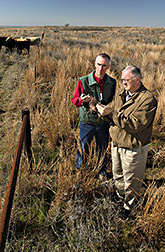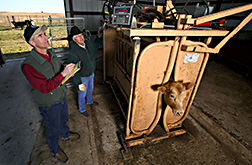Range That’s a Home to Forage Research
Capped by a large, open sky, northwestern Oklahoma’s vast, rolling grasslands create a visually overwhelming lands cape—one that calls people to stop and try to soak it all in. Yet it is within this expanse’s small details that one finds the pulse of the U.S. Southern Plains, a vital region that helps feed millions of people worldwide.
The Southern Plains’ soils, plants, insects, and animals serve as a window into the region’s past, present, and future; its economic vitality; and the state of its people and wildlife.
Scientists at ARS’s Southern Plains Range Research Station (SPRRS) in Woodward, Oklahoma, are using these details to mold a comprehensive plan for tying together—and improving—the region’s agriculture, ecology, and culture. And in this endeavor, says station research leader Phillip Sims, the scientists have a great asset in the Southern Plains Experimental Range (SPER).
The experimental range is one of eight such facilities operated by ARS. Located outside the rustic, historic community of Fort Supply, about 17 miles northwest of Woodward, SPER spreads out over 4,300 acres of prairie.
“It’s a spectacular and unique outdoor laboratory, great in scope, breadth, and history,” says ARS rangeland scientist Robert Gillen.
Endowed with sandy soils derived from the nearby North Canadian River, the range is host to native plants—mostly sand sage (Artemisia filifolia) and grasses such as sand bluestem (Andropogon hallii), little bluestem (Schizachyrium scoparium), sand dropseed (Sporobolus cryptandrus), and blue grama (Bouteloua gracilis). About 3,700 of its acres are devoted to rangeland studies, while 600 are used for examining newly developed pasture and farmed forages. Gillen says the range is home to about 120 cow-calf pairs and more than 400 yearling beef steers.
“A main mission at Woodward is to develop integrated forage systems that provide productive, year-round livestock feeding,” says Sims. “SPER plays a vital role in helping us achieve this goal.”
“Its size and diversity allow for large-scale, real-time testing of both management strategies and forage germplasm that scientists here and at other locations develop,” says Gillen. He adds that SPER made testing possible by agronomist Timothy Springer of two new grass cultivars: Chet sand bluestem, which was released in 2004, and Verl eastern gama-grass, which was released in 2005.
Forage crops, pasture, and rangelands are important in feeding ruminant animals tied to the meat and dairy industries. The vast majority of the 100 million head of cattle and 6 million sheep in the United States depend on forage grasses at some time in the production cycle.
An Asset for 65 Years
|
|
Since becoming part of SPRRS in 1940, SPER has helped the Woodward lab uphold its tradition of keeping use of Plains land in sync with the needs of its people. When USDA established the Southern Great Plains Field Station in Woodward in 1913 (it was given its current name in 1978), it did so in response to a regional increase in plowed land, as native grasslands were converted to cropland. Crop production was blossoming until the Plains were devastated in the 1930s Dust Bowl era.
Afterwards, Plains agriculturists turned their attention back to forages, and USDA purchased land for the experimental range and placed it under the Woodward station’s responsibility. “From that point on,” says Sims, “the focus here became developing and providing research-based management guidelines for rangeland and pastures in the region.”
Current SPER projects have potential to affect the Southern Plains—and the world—far into the future, and even beyond agriculture. One such program is determining the right amount of livestock and wildlife grazing to promote proper mineral cycling. Sims says particular attention is being paid to carbon balance.
“We’re examining ways for growers to sequester carbon and, perhaps, one day earn money from doing so. We’re also evaluating systems that complement both forage and livestock, improving cropland- and pasture-restoration techniques, and examining the importance of plant diversity for sustainable management of restored grasslands,” says Sims.
Untouched Since 1941
Dotting the range’s rolling hills are fenced-off areas that don’t seem very different from the land outside them, save for somewhat taller grasses. “And that’s just the way we want them to look,” says Gillen. “That sameness is indicative of proper management, of proper land use.”
The 3- to 6-acre fenced-off plots—“exclosures,” as Gillen calls them—are one of SPER’s more significant features. “They’ve been undisturbed since 1941,” he says. “They help us gauge the ecosystem’s overall health. We use them to study how grazing influences plant diversity, energy capture, and cycling of minerals such as carbon and nitrogen.”
Gillen adds that the key to the exclosures is not what’s inside them, but what’s outside: “There shouldn’t be vast differences,” he says. “We don’t want to see lots of short grass and bare ground on the outside. That’s a sign of bad management.”
With the help of the exclosures, Sims and Bill Berg, a former ARS soil scientist who’s now retired, found that proper grazing was just as effective as 55 years of total protection in maintaining soil carbon and nitrogen.
“Grazing caused a moderate change in the mix of plant species, but total plant production was equal inside and outside of the exclosures,” says Sims.
Keeping Tabs on Carbon
|
|
The studies on carbon budgets may affect a much-discussed topic in agricultural and climate-studies circles: carbon sequestration. Plants take in carbon dioxide and use the carbon to grow. When they die, the carbon returns to the soil and atmosphere as they decompose. ARS is working to develop a national estimate of how much carbon U.S. farm and grazingland soils are currently storing in what is, in effect, a net carbon bank.
It’s thought that with improved management, farms and rangelands could store enough carbon to partially quell climate change, which many believe is brought on by an increase in greenhouse gases. (See “Depositing Carbon in the Bank,” Agricultural Research, February 2001, pp. 4-7.)
Sims explains that such work may eventually lead to a system in which farmers and ranchers are paid for the amount of carbon their land can store. “Theoretically, a rancher with livestock would manage the land at a certain stocking rate or grazing intensity, aiming for grasses as robust as possible while still adequately feeding the livestock,” says Sims.
In another project, SPRRS scientists seek to manage grazing so that the prairie ecosystem, including one near-endangered species, is protected and thrives.
Studies on optimal sagebrush management for livestock and wildlife production make up a relatively new project, which Gillen is heading. “It represents the latest shift in thinking here and corresponds to the lab’s history,” he says. “We’re looking not only at livestock production, but also at how we can integrate it into—and improve—the overall habitat.”
Aiding Lesser Prairie Chickens
Gillen says this push was sparked by a decrease in lesser prairie chickens, Tympanuchus pallidicinctus, which are grassland-nesting birds being considered for listing as a threatened species. Conversion of native rangelands to cropland, removal of shrubs with herbicides, landscape fragmentation, excessive grazing, and drought periods have contributed to its decline.
“Sagebrush is a key habitat component for this bird,” says Gillen. “In the past, emphasis was put on getting rid of sagebrush, because cattle don’t eat it. Now we want to find the optimal levels of sage that would increase lesser prairie chickens while maintaining livestock production.” He adds that two other pieces of the puzzle are grasshoppers, an important food, and wildflowers, which furnish both food and cover for lesser prairie chickens.
Yet perhaps the most significant work at SPER involves complementary forages.
“In our region, almost every producer has two to four different forage types available,” says Gillen. “We take all these and their subtypes and integrate them into a complete, year-round forage system that optimizes their individual advantages while minimizing their disadvantages.” Forages the researchers are working with include native rangeland, winter wheat, Sudan grass, Old World bluestems, and wheatgrasses.
“No single forage can supply the nutritional requirements of grazing beef cattle for more than a few months during the year,” says Sims. “By combining different types of forages together in a system, we can increase the amount of time during the year when forage quality and quantity will be high enough to support efficient beef gains.”
“The significance here is that we may have provided growers with what they need to double their livestock production and net profits on a per-acre basis,” says Gillen.
SPER’s beautiful landscape serves as a real-world test bed for the research conducted by the scientists based in Woodward.
“It’s an ideal location in which to test our forage germplasm. It’s a unique situation because it allows us to release grasses that were not just tested in small plots. The range is a natural treasure that allows us to develop germplasm and devise management practices based on real conditions. It helps us serve the intricate, interacting ecosystems of the Southern Plains and the people who rely on them.”—By Luis Pons, Agricultural Research Service Information Staff.
This research is part of Rangeland, Pasture, and Forages, an ARS National Program (#205) described on the World Wide Web at www.nps.ars.usda.gov.
Phillip L. Sims and Robert L. Gillen are at the USDA-ARS Southern Plains Range Research Station, 2000 18th St., Woodward, OK 73801; phone (580) 256-7449, fax (580) 256-1322.
"Range That’s a Home to Forage Research" was published in the June 2005 issue of Agricultural Research magazine.










